| |
|
Xiamen Oil Paintings, Wholesale Direct!
|
|
100% hand painted, 100% cotton canvas, 100% money back if not satisfaction. |
|
|
|
|
ART WORKS INDEX
A
B
C
D
E
F
G
H
I
J
K
L
M
N
O
P
Q
R
S
T
U
V
W
X
Y
Z
|
|
ARTISTS INDEX
A
B
C
D
E
F
G
H
I
J
K
L
M
N
O
P
Q
R
S
T
U
V
W
X
Y
Z
|
|
|
|
 |
Xanthus Russell Smith
|
|
Marine, landscape, portrait, and historical painter.
American , 1839-1929
was an American artist best known for his illustrations of the American Civil War. Born in Philadelphia, Smith served in the United States Navy during the war and depicted naval battles with a variety of media, including pencil and oil paint. His best known work (right) recreates the 1864 battle between the CSS Alabama and USS Kearsarge off Cherbourg, France. Smith did not actually participate in most of the battles he illustrated; instead, he generally consulted those who were present at the engagements.
|
|
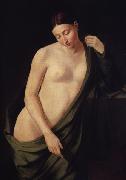 |
Wojciech Stattler
|
|
(1800, Krakew - 1875) was a Polish painter of Swiss aristocratic ancestry and a long-standing professor of the School of Fine Arts in Krakew.
|
|
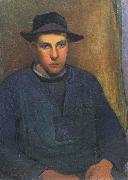 |
Wladyslaw slewinski
|
|
(1854-1918) was a Polish painter. He was a student of Gauguin's and a leading artist of the Young Poland movement.
Władysław Ślewiski was a Polish painter. He administered his estate in Poland before traveling to Paris in 1888. Once there he studied at the Academie Colarossi where he met Gauguin. The impression this encounter made on him and Gauguin's encouragement prompted Slewinski to dedicate himself to art. He submitted to Gauguin's artistic and personal influence, spending time with him in Paris and, from 1889, in Pont-Aven and Le Pouldu in Brittany.
Seascapes painted during this period include Cliffs in Brittany. In 1891 Gauguin painted a portrait of Slewinski and presented it to him. During this period Slewinski exhibited in Paris, with some success, both at the Salon des Independents in 1895 and 1896 and the Galerie Georges Thomas in 1897 and 1898.
|
|
|
|
|
|
 |
William Strutt
|
|
English Painter, ca.1825-1915
was an English artist. Strutt was born in Teignmouth, Devon, England, and came from a family of artists, his grandfather, Joseph Strutt, was a well-known author and artist, his father, William Thomas Strutt, was a good miniature painter. William Strutt enjoyed a student life in Paris, France, and England, studying figurative and history painting. In response to a near-breakdown and problems with his eyes, Strutt decided to visit Australia, arriving 5 July 1850 on the Culloden, where he then married. In Melbourne, Strutt found employment as an illustrator on the short-lived Illustrated Australian Magazine, published by Thomas Ham, as there was little demand for the figurative and history paintings for which he was trained. Some of his designs did, however, lead to commissions, including a design for a new postage stamp, and an Anti-Transportation League card. Despite the lack of interest for major history paintings in Melbourne, Strutt continued to sketch suitable subjects, including the "Black Thursday" bushfires, which swept over the colony on 6 February 1851. It was from these sketches that Strutt composed one of his most notable paintings some 10 years later, Black Thursday, February 6th. 1851, 1864, which depicted animals and men fleeing from the fire. In February 1852, Strutt joined the growing tide of men travelling to the gold-fields surrounding Ballarat, Victoria. Despite working in the gold fields for eighteen months he found little success. He returned to Melbourne in mid-1853 and became actively involved in the city's cultural scene, undertaking a number of portrait commissions and joining the Victorian Society of Fine Arts as a founding member. William Strutt, Portrait of John Pascoe Fawkner, founder of Melbourne, 1856: oil on canvas; 61.3 x 51.2 cm. National Library of Australia.Strutt's interest in depicting the notable events of the colony was piqued by the events surrounding the Victorian Exploring Expedition led by Burke and Wills in 1860-61. He made several studies of their preparations at Royal Park, Melbourne, and followed the expedition to its first camp at Essendon, Victoria. Strutt also collected first-hand accounts from the rescue party and from John King,
|
|
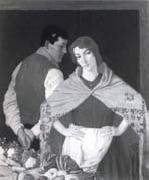 |
William Strang
|
|
British Painter, 1859-1921,Scottish painter and printmaker. Following a brief apprenticeship with a shipbuilding firm in Clydesdale, he entered the Slade School of Art (1876) where he adhered to the uncompromising realism advocated by his teacher Alphonse Legros. After completing his studies at the Slade (1880), Strang became Legros's assistant in the printmaking class for a year. For the next 20 years he worked primarily as an etcher. His etchings include landscapes in the tradition of Rembrandt, pastoral themes indebted to Giorgione and macabre genre subjects, marked by a sense of tension and suspended animation. He also etched 150 portraits of leading artistic and literary figures. The commitment to realism and psychological intensity that characterizes the best of Strang's etched work is also evident in the paintings that dominated the latter half of his career. The influence of the Belgian and French Symbolists' work and Strang's growing confidence in the handling of colour combined in his mature style with a linear clarity and schematic colouring that is best seen in such works as Bank Holiday (1912; London, Tate). His oil portraits, for example Vita Sackville-West as Lady In a Red Hat (1918; Glasgow, A.G. & Mus.), are strikingly potent images of their time. An important collection of Strang's graphic work is in the Art Gallery and Museum in Glasgow.
|
|
|
|
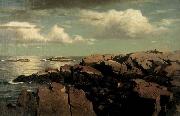 |
William Stanley Haseltine
|
|
(June 11, 1835-February 3, 1900) was an American painter and draftsman who was associated with the Hudson River School and Luminism.
Born in Philadelphia to John Haseltine, a successful businessman, and Elizabeth Shinn Haseltine, an amateur landscape painter, Haseltine studied at the University of Pennsylvania and then at Harvard University, where he received a degree in 1854.
He first exhibited his paintings the following year at the Pennsylvania Academy of Fine Arts, after which he sailed to Europe, first joining a colony of American painters who were studying in Dusseldorf, then traveling up the Rhine into Switzerland and Italy. In late 1857 he settled in Rome, and in the following months made numerous excursions to draw the landscape around Rome and on Capri.
In 1858 Haseltine returned to Philadelphia, and by late 1859 was installed in the Tenth Street Studio Building in New York City, then a central point for American landscape painters; also in the building were Frederic Edwin Church, Albert Bierstadt, and Worthington Whittredge, the latter two having befriended Haseltine in Europe. Though many of his paintings from this time derived from his European sketches, Haseltine also began to paint the oceanside of New England, especially favoring the rockbound coasts of Narragansett, Rhode Island, Nahant, Massachusetts, and Mount Desert Island, Maine. The precision with which he painted these landscapes won critical praise, and Haseltine was elected an Associate of the National Academy of Design in 1860, and a full Academician in 1861.
In 1864 Haseltine's wife died in childbirth. He spent some time training his nephew, Howard Russell Butler, but he moved after he married Helen Marshall in 1866. Initially the family considered settling in Paris, but in 1867 they moved to Rome, which would for most of Haseltine's subsequent years serve as his home and point of departure from which to produce views of the European landscape. While his paintings of Capri and Sicily would prove popular with visiting American tourists, Haseltine also traveled and drew in France, Holland, Belgium, and the Netherlands, summering in Bavaria and the Tyrol in the 1880s and 1890s. In his later years he also returned periodically to the United States, making a final trip to the west in 1899.
Haseltine died of pneumonia in Rome in 1900.
|
|
|
|
|
|
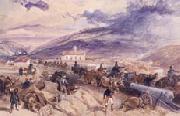 |
William Simpson
|
|
British Painter (1823-1899)
was a British artist and war correspondent. Born into poverty in Glasgow on 28 October 1823, Simpson went on to become one of the leading 'special artists' of his day, and sketched many scenes of war for the Illustrated London News. His early years were very difficult living in a house with an abusive and alcoholic father, and in 1834 he was sent to live with his grandmother in Perth. Simpson's only formal schooling took place during this period and within a few years, he was working as an apprentice in the Glasgow lithographic firm of Macfarlane. The artist stated later that "this was the turning point which changed all my boyish intentions." It was during the years in Glasgow that he attended the Andersonian University and the Mechanics Institute in the evenings. His next position was with the lithographic company of Allan and Ferguson where he spent four years learning the trade. In 1851 Simpson moved to London where he was hired by Day & Sons. While at Day's he was able to work on several important lithographic sets. He became famous initially for his work in the Crimean War where he was sent by the firm of Colnaghi to create a series of watercolors suitable for lithographing. In the late 1850's he was sent to India to sketch scenes relating to the recent Sepoy Revolt. He joined the ILN in 1866 and covered the Abyssinian Campaign of 1868. In 1870 he went to France to sketch the war with Prussia, and in the following year observed the barricades of the Paris Commune. During a trip around the world, he stopped off in California and traveled to the Lava Beds area to report on the Modoc War in 1873. Five years later, he journeyed to Afghanistan to provide illustrations of the Second Afghan War that had broken out; he returned to London in the summer of 1879. In 1890, he observed the opening of the Forth Bridge and caught a chill which was to have detrimental effects on his health. He died at home in Willesden, north London, on August 17, 1899, and was buried in Highgate Cemetery. Besides his war pictures, he covered state events, coronations, funerals, and other ceremonies. He was particularly interested in India and sketched scenes of the Kashmir Maharajas.
|
|
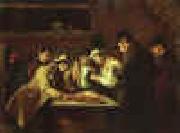 |
William Sidney Mount
|
|
1807-1868
William Sidney Mount Galleries
William Sidney Mount (November 26, 1807 ?C November 19, 1868) born in Setauket, New York was a renowned genre painter and contemporary of the Hudson River School. Mount trained at the National Academy of Design in New York. Two of his more famous paintings are Eel Spearing at Setauket (1845, New York State Historical Association, Cooperstown) and Bargaining for a Horse (1835, New-York Historical Society, New York City). Beginning as a history painter, Mount moved to depicting scenes from everyday life. The largest collection of his works is located in The Long Island Museum of American Art, History, and Carriages
His home and studio, the William Sidney Mount House, is a National Historic Landmark. One of the local elementary schools in The Three Village Central School District is named in his honor, as is PS 174 elementary school in Rego Park, Queens. A residential building is named after him on the Stony Brook University campus.
|
|
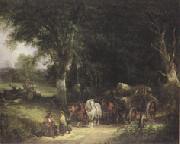 |
William Shayer
|
|
1787-1879
English painter. Although based in Southampton and catering predominantly to a provincial market, he also exhibited in London. Between 1825 and 1870 he showed over 330 works at the Royal Society of British Artists and 80 at the British Institution. Shayer produced rural genre scenes in the manner of Francis Wheatley, Julius Caesar Ibbetson and, predominantly,
|
|
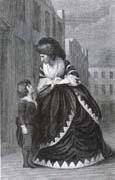 |
William Sharp
|
|
British 1749-1824,was an English line-engraver born in London. He was originally apprenticed to what is called a bright engraver, and practised as a writing engraver, but gradually became inspired by the higher branches of the engraver's art. Among his earlier plates are some illustrations, after Stothard, for the Novelists' Magazine. He engraved the "Doctors Disputing on the Immaculateness of the Virgin" and the "Ecce Homo" of Guido Reni, the "St Cecilia" of Domenichino, the "Virgin and Child" of Dolci, and the portrait of John Hunter of Sir Joshua Reynolds. His style of eta-graving is thoroughly masterly and original, excellent in its play of line and rendering of half-tints and of "colour." He died at Chiswick on the 25th of July 1824. In his youth, owing to his hotly expressed adherence to the politics of Paine and Horne Tooke, he was examined by the privy council on a charge of treason. Mesmer and Brothers found in Sharp a stanch believer; and for long he maintained Joanna Southcott at his own expense. As an engraver he achieved a European reputation, and at the time of his death he enjoyed the honour of being a member of the Imperial Academy of Vienna and of the Royal Academy of Munich.
|
|
 |
william shakespeare
|
|
Born: 23 April 1564
Birthplace: Stratford-upon-Avon, England
Died: 23 April 1616
Best Known As: The famed author of Romeo and Juliet
|
|
|
|
 |
William Scrots
|
|
William (or Guillim) Scrots (or Scrotes or Stretes) (active 1537-1553) was a painter of the Tudor court and an exponent of the Mannerist style of painting in the Netherlands. He is first heard of when appointed a court painter to Mary of Habsburg, Regent of the Netherlands, in 1537. In England, he followed Hans Holbein as King's Painter to Henry VIII in 1546, with a substantial annual salary of £62 10s, over twice as much as Holbein's thirty pounds a year. He continued in this role during the reign of the boy king Edward VI. His salary was stopped on Edward's death in 1553, after which it is not known what became of him, though it is presumed he left England.
Edward VI, attributed to Scrots, Hampton Court.
Portrait of Edward VI in distorted perspective, 1546.Little more is known of Scrots than that his paintings showed an interest in ingenious techniques and detailed accessories. Scrots was paid 50 marks in 1551 for three "great tables", two of which were portraits of Edward delivered to the ambassadors Thomas Hoby and John Mason as gifts for foreign monarchs, and the third a "picture of the late earle of Surrey attainted." Two full-length portraits of Edward VI in a pose similar to that of Holbein's portrait of his father, one now in the Royal Collection (left) and another now in the Louvre (below), are attributed to Scrots and are likely to be these two paintings. Scrots also painted an anamorphic profile of Edward VI, distorted so that it is impossible to view it normally except from a special angle to the side. This optical trick is similar to that used by Holbein in his painting The Ambassadors and in contemporary portraits of Francis I and Ferdinand I. Later, when the painting was exhibited at Whitehall Palace in the winter of 1591-92, it created a sensation, and important visitors were all taken to see it.
|
|
|
|
|
|
|
|
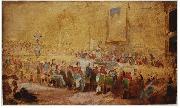 |
William Salter
|
|
painted Sketch of the 1836 Waterloo Banqet by William Salter in 1836
|
|
|
|
|
|
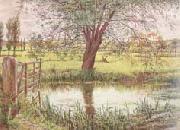 |
William Bell Scott
|
|
1811-1890
Brother of David Scott. He trained at the Trustees' Academy in Edinburgh and was taught engraving by his father. He saw the family print workshop as 'the lineal descendant of Albert Derer's factory in Nernberg'; he was later to own a fine collection of D?rer's prints and write a book about him (1870). In 1837 he went to London, where he was impressed by 'a new and interesting school of historical and loosely speaking, inventive and illustrative painters'. This encouraged him to leave landscape painting for the time being and become a history painter. Like his brother, he entered a cartoon for the Westminster Hall competition in 1842: the Free North Britons Surprising the Roman Wall between the Tyne and Solway; this too was unsuccessful. In 1843, discouraged by lack of patronage in London, he accepted the Mastership of the Government School of Design at Newcastle upon Tyne, where he stayed for 20 years, visiting London each summer.
|
|
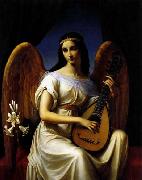 |
Wilhelm von Schadow
|
|
German Romantic Painter, 1788-1862,Painter, teacher and writer, son of Johann Gottfried Schadow. He studied at the Berlin Akademie from 1805 and in 1806 showed paintings at the annual Akademie exhibition. Under his teacher, Friedrich Georg Weitsch, he quickly became a skilled portrait painter, and by 1810 he was commissioned to paint portraits of members of the Prussian royal family and of the Empress of Austria. Influenced by the English artist John Flaxman, Schadow developed an emphasis on outline. In 1810 Schadow went with his brother Ridolfo Schadow to Rome, where in 1813 he became a member of the Lukasbreder and, in 1814, a Catholic. In 1815-17 he took part, with Peter von Cornelius, Friedrich Overbeck and Philipp Veit, in the commission for frescoes of the Story of Joseph for a room in the Casa Bartholdy (now Berlin, Alte N.G.). In his continuing interest in portraits, Schadow differed from his colleagues. Following the example of Gottlieb Schick and similarly inspired by Raphael, Schadow developed a poetic style of portraiture. In 1819 he returned to Berlin in order to help Karl Friedrich Schinkel with the decoration of the Schauspielhaus. He took over the running of a studio and won a high degree of respect as a painter and teacher.
|
|
|
|
|
|
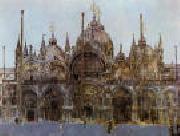 |
Walter Sickert
|
|
German
1860-1942
Walter Sickert Gallery
Walter Richard Sickert (May 31, 1860 in Munich, Germany ?C January 22, 1942 in Bath, England) was a German-born English Impressionist painter. Sickert was a cosmopolitan and eccentric who favoured ordinary people and urban scenes as his subjects
He developed a personal version of Impressionism, favouring sombre colouration. Following Degas' advice, Sickert painted in the studio, working from drawings and memory as an escape from "the tyranny of nature".[3] Sickert's earliest major works were portrayals of scenes in London music halls, often depicted from complex and ambiguous points of view, so that the spatial relationship between the audience, performer and orchestra becomes confused, as figures gesture into space and others are reflected in mirrors. The isolated rhetorical gestures of singers and actors seem to reach out to no-one in particular, and audience members are portrayed stretching and peering to see things that lie beyond the visible space. This theme of confused or failed communication between people appears frequently in his art.
By emphasising the patterns of wallpaper and architectural decorations, Sickert created abstract decorative arabesques and flattened the three-dimensional space. His music hall pictures, like Degas' paintings of dancers and caf??-concert entertainers, connect the artificiality of art itself to the conventions of theatrical performance and painted backdrops. Many of these works were exhibited at the New English Art Club, a group of French-influenced realist artists with which Sickert was associated. At this period Sickert spent much of his time in France, especially in Dieppe where his mistress, and possibly his illegitimate son, lived
|
|
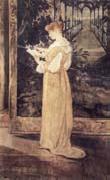 |
Walter Shirlaw
|
|
Scottish-American artist , 1838-1909
was a Scottish-American artist. Shirlaw was born in Paisley, Scotland, and moved to the United States with his parents in 1840. He worked as a bank-note engraver, and his work was first exhibited at the National Academy in 1861. He was elected an academician of the Chicago Academy of Design in 1868. Among his pupils there was Frederick Stuart Church. From 1870 to 1877 he studied in Munich, under George Raab, Richard Wagner, Arthur George von Ramberg, and Wilhelm Lindenschmidt. His first work of importance was the Toning of the Bell (1874), which was followed by Sheep-shearing in the Bavarian Highlands (1876). The latter, which is probably the best of his works, received honorable mention at the Paris exposition in 1878. Other notable works from his easel are Good Morning (1878), in the Buffalo Academy; Indian Girl and Very Old (1880); Gossip (1884); and Jealousy (1886), owned by the Academy of Design, New York. His largest work is the frieze for the dining-room in the house of Darius O. Mills in New York. Shirlaw has also earned an excellent reputation as an illustrator. He was one of the founders of the Society of American Artists, and was its first president. On his return from Europe he took charge of the Art Students League of New York, and for several years taught in the composition class.
|
|
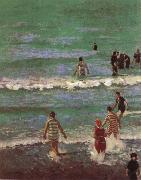 |
Walter Richard Sickert
|
|
British Camden Town Group Painter, 1860-1942
British painter, printmaker, teacher and writer of German birth. Sickert was one of the most influential British artists of this century. He is often called a painter painter, appealing primarily to artists working in the figurative tradition; there are few British figurative painters of the 20th century whose development can be adequately discussed without reference to Sickert subject-matter or innovative techniques. He had a direct influence on the Camden Town Group and the Euston Road School, while his effect on Frank Auerbach, Howard Hodgkin and Francis Bacon was less tangible. Sickert active career as an artist lasted for nearly 60 years. His output was vast. He may be judged equally as the last of the Victorian painters and as a major precursor of significant international developments in later 20th-century art, especially in his photo-based paintings.
|
|
|
|
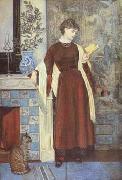 |
Walter Crane,RWS
|
|
1845-1915
English painter, illustrator, designer, writer and teacher. He showed artistic inclinations as a boy and was encouraged to draw by his father, the portrait painter and miniaturist Thomas Crane (1808-59). A series of illustrations to Tennyson's The Lady of Shalott (Cambridge, MA, Harvard U., Houghton Lib.) was shown first to Ruskin, who praised the use of colour, and then to the engraver William James Linton, to whom Crane was apprenticed in 1859. From 1859 to 1862 Crane learnt a technique of exact and economical draughtsmanship on woodblocks. His early illustrative works included vignette wood-engravings for John R. Capel Wise's The New Forest: Its History and its Scenery (1862).
|
|
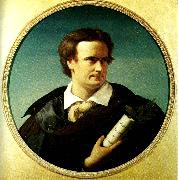 |
w. von schadow
|
|
Friedrich Wilhelm Schadow (7 September 1789 - 19 March 1862) was a German Romantic painter.
He was born in Berlin and was the second son of the sculptor Johann Gottfried Schadow.
In 1806-1807 Friedrich served as a soldier. In 1810 he traveled with his elder brother Rudolph to Rome where he became one of the leaders among painters of the Nazarene movement. Following the example of Johann Friedrich Overbeck and others, he joined the Roman Catholic Church, and held that an artist must believe and live out the truths he essays to paint. The sequel showed that Schadow was qualified to shine more as a teacher and mentor than as a painter. As an author, he is best known for his lecture, Ueber den Einfluss des Christentums auf die bildende Kunst (About The Influence of Christianity On The Visual Arts) (Dusseldorf, 1843), and the biographical sketches, Der moderne Vasari (Berlin, 1854).
In Rome, Schadow was given one of his first major commissions when the Prussian Consul-General, General Jakob Salomon Bartholdy, befriended the young painter, and asked him and three young compatriots (Cornelius, Overbeck and Veit) to decorate in fresco a room in his house on the Pincian Hill. The overall theme selected was the story of Joseph and his brethren, and two scenes, the Bloody Coat and Joseph in Prison, were conferred on Schadow. In 1819, Schadow was appointed professor in the prestigious Berlin Academy of the Arts, and his ability and thorough training gained many devoted disciples.
It was during this period that Schadow developed his paintings for churches. In 1826, Professor Schadow was made director of the Dusseldorf Academy of the Arts, which he reoriented towards the production of Christian art, though he began a major dispute with one of its professors, Heinrich Christoph Kolbe, ending in the latter leaving the Academy in 1832. In 1837, Schadow selected, at request, those of his students best qualified to decorate the chapel of St Apollinaris on the Rhine with frescoes. When finished, they were acclaimed as the fullest and purest manifestation of the spiritual side of the D??sseldorf school. One of his famous students, Heinrich Mucke, carried on the liturgical art with emphasis both in painting and frescoes. The painting of the Wise and Foolish Virgins. considered one of his masterworks, was commissioned in 1842. Now in the Städel Museum, this large and important picture, while carefully considered and rendered, it however lacks power of some of his other works.
Schadow's fame rests less on his own artistic creations than on the school he formed. In D??sseldorf a reaction set in against the spiritual and sacerdotal style he had established and, in 1859, the party of naturalism, after a severe struggle, drove Director Schadow from his chair. Friedrich Wilhelm Schadow died at Dusseldorf in 1862, and a monument was erected in the square which bears his name at a jubilee held to commemorate his directorate.
The D??sseldorf School that Schadow directed became internationally renowned, attracting such American painters as George Caleb Bingham, Eastman Johnson, Worthington Whittredge, Richard Caton Woodville, William Stanley Haseltine, James M. Hart, and William Morris Hunt and producing the German emigre Emmanuel Leutze.
|
|
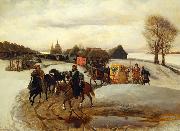 |
Vyacheslav Schwarz
|
|
painted The Spring Pilgrimage of the Tsarina, under Tsar Aleksy Mihailovich in 1868
|
|
|
|
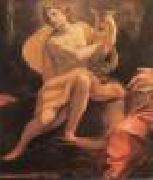 |
VOUET, Simon
|
|
French Baroque Era Painter, 1590-1649
French painter and draughtsman. Although at the time regarded as one of the leading French painters of the first half of the 17th century, he is now known more for his influence on French painting than for his actual oeuvre. He made his reputation in Italy, where he executed numerous portraits for aristocratic patrons and was commissioned for religious subjects. Although the early Italian works show the influence of Caravaggio, his work was subsequently modified by the Baroque style of such painters as Lanfranco and the influence of the Venetian use of light and colour. When he was summoned back to France by Louis XIII in 1627 he thus brought with him an Italian idiom hitherto unknown in France that revitalized French painting
|
|
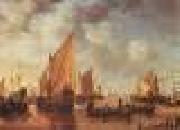 |
VLIEGER, Simon de
|
|
b. 1601, Rotterdam, d. 1653, Weesp..Dutch painter, draughtsman, etcher and stained-glass designer. He was one of the leading marine and landscape artists of the Dutch school and decisively influenced the direction of Dutch marine art during the 1630s and 1640s. His late works anticipated the shift from the monochrome or tonal phase of Dutch marine art to the more classical style of Jan van de Cappelle and Willem van de Velde the younger
|
|
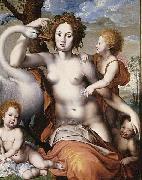 |
Vincent Sellaer
|
|
painted Leda with Swan and Children in1st half of 16th century
|
|
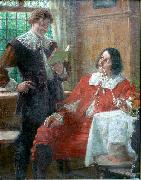 |
Victor Schivert
|
|
(1863-1926?) was a renowned Romanian painter
He painted illustrations of the Thirty Years War.
One of his paintings "Kriegsbeute" was reported stolen in 2005 from Bohemia (Czech Republic).
|
|
|
|
|
|
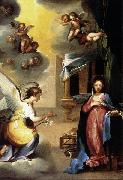 |
Ventura Salimbeni
|
|
(also later called Bevilacqua; 20 January 1568 - 1613) was an Italian Mannerist painter and printmaker and among the last representatives of a style influenced by the earlier Sienese School of Quattrocento-Renaissance.
Salimbeni was born in Siena. He studied painting, together with his half-brother Francesco Vanni, under their father Arcangelo Salimbeni in his native Siena,
He possibly spent some time,in Northern Italy and then moved to Rome in 1588 to work, together with others, on the fresco painting of the Vatican Library under pope Sixtus V.
During 1590-1591, he got a commission by Cardinal Bonifazio Bevilacqua Aldobrandini for paintings in the Roman Jesuit Church of the Gese and the Basilica di Santa Maria Maggiore. These paintings show the influence of the Mannerist Cavalier D'Arpino and Andrea Lillio.
Salimbeni returned to Siena in 1595. Here he became one of the last leaders of the Mannerist school, in this period between Mannerism and Baroque. He was here influenced by Federico Barocci as can be seen in the draperies, highlighted with abrupt changes of light and flickering surfaces, of his painting "Birth of a Virgin" in the San Domenico church in Ferrara (1607-1608).
He completed painting cycles (1595-1602) for Sienese churches such as the oratory in the Santa Trinite. He is known for detailed preparatory drawings, most of which are now in the Uffizi in Florence or the Fine Arts Museum of San Francisco. He started around 1600 painting the scenes from the "Life of St. Hyacinth" for the Sienese church of Santo Spirito. These paintings show the awkward perspective of the style of the Sienese Mannerist painter Beccafumi in the backdrop of buildings and landscape. In Siena, Salimbeni completed several painting cycles for the church of Santo Spirito. He continued to create paintings for churches throughout Italy, including Florence. At the Basilica della Santissima Annunziata di Firenze, he frescoed lunettes (1605-1608) illustrating events in the history of the Servite Order. In the Duomo di San Salvatore, he executed a magnificent John the Baptist.
At about the same time, around 1600, he got an assignment in Assisi for a fresco of the "Resurrection of Christ" and the "Dying Saint Clare is visited by the pope" in the vault of chapel of San Massimo in the Basilica of Santa Maria degli Angeli.
Salimbeni got in 1603 the commission to paint frescoes with scenes from the church's patron saints in the church of Quirico and Giulitta, one of the oldest churches in Siena. As in the church of Santa Trinite, he worked here alongside with the painter Alessandro Casolari.
This was a period on non-stop new assignments : three paintings for the church San Lorenzo in San Pietro in Montalcino, the "Donation of the Keys" (1599), the "Disputa of the Eucharist" (1600) and the "Crucifixion" (1604).
At the same time he was painting the "Vision of Gregory the great" and the "Punishment of David" in the Basilica of San Pietro in Perugia. The papal legate, cardinal Bonifazio Bevilacqua (1571-1627), who had commissioned these paintings, was so pleased that he invested Ventura Salimbeni with the Order of the Golden Spur, a very selective papal order. He was even authorized from now on to name himself Cavalieri Bevilacqua. He painted the canvas of the Ascension of the Virgin (1607) for San Frediano in Pisa.
In 1612 he painted the "Life of Saint Galganus" for the Chiesa del Santuccio in Siena with the hermit saint set in a wooded landscape.
His last work of art was the oil painting the "Marriage of the Virgin" for the Seminario diocesano in Foligno in 1613.
|
|
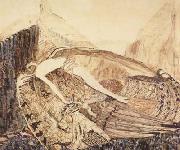 |
Vasily Surikov
|
|
Russian Painter, 1848-1916
Russian painter. He is principally noted for his treatment of episodes from the 17th century and the medieval period of Russian history. These works are remarkable for their thoroughly researched and detailed rendering of settings and costume and the drama of their presentation. Surikov was also an accomplished portrait painter and incorporated a large number of portrait studies into his history paintings.
|
|
|
|
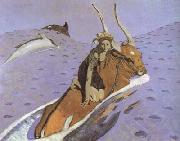 |
Valentin Aleksandrovich Serov
|
|
Russian Painter, 1865-1911
Russian painter, graphic artist and stage designer. As a child he lived in St Petersburg, but he made frequent trips abroad. In 1874 he travelled to Paris with his mother and frequented the studio of the Russian Realist painter, Il'ya Repin. In 1875 the art patron Savva Mamontov invited Serov and his mother to settle at ABRAMTSEVO outside Moscow, where he again had the opportunity to study under Repin and to meet other artists in the Mamontov circle. The Symbolist paintings of Mikhail Vrubel' and the late Impressionist landscapes and figure studies of Konstantin Korovin he saw at Abramtsevo had a lasting influence on the young Serov. From 1880 to 1885 he studied at the Academy of Art, St Petersburg, under Pavel Chistyakov (1832-1919). During the 1880s Serov also travelled abroad and became aware of French Impressionism. He began to use bright colours in portraits of figures seen in dappled sunlight and shade, as in his portrait of Vera Mamontov, Girl with Peaches (1887) and a portrait of Mariya Simonovich, Girl in Sunlight (1888; both Moscow, Tret'yakov Gal.).
|
|
|
|
|
|
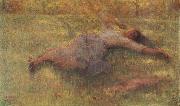 |
Tudor St George Tucker
|
|
1862 - 1906,was the son of Captain Charlton Nassau Tucker, a cavalry officer in the East India Company's service. He came to Melbourne in 1881. He studied at the national gallery school and afterwards at Paris. He returned to Melbourne and about the year 1893 was associated with E. Phillips Fox in the conduct of the Melbourne art school. He was back in London in 1899 working in a studio at Chelsea, and had two paintings in the 1900 Royal Academy exhibition, two in 1901 and one in 1902. He died in London in 1906. He suffered much from ill health and his work is comparatively little known.
|
|
 |
Tobias Stimmer
|
|
(7 April 1539 - 4 January 1584) was a Swiss painter and illustrator. His most famous work is the paintings on the Strasbourg astronomical clock. He died in Strasbourg.
He was born in Schaffhausen, and was active in Schaffhausen, Strasbourg and Baden-Baden as a wall and portrait painter. He made a great number of drawings for woodcuts (Bible scenes, allegories, etc.) which were published by the printer Sigmund Feyerabend in Frankfurt am Main, and Bernhart Jobin in Strasbourg.
Stimmer followed Hans Holbein the Younger, but developed his own mannerism. Among his wall paintings remain the "House zum Ritter" in Schaffhausen, although this was actually much restored and changed.
|
|
|
|
|
|
|
|
|
| Wholesale China Oil Painting Wholesale Oil Painting China Xiamen Portrait Reproduction on canvas Chinese Oil Painting Wholesale USA Oil Painting |
|
|
|
|
|